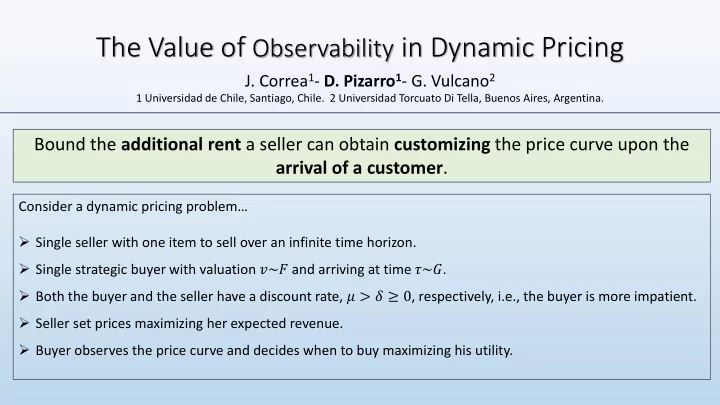

The Value of Observability in Dynamic Pricing J. Correa 1 - D. Pizarro 1 - G. Vulcano 2 1 Universidad de Chile, Santiago, Chile. 2 Universidad Torcuato Di Tella, Buenos Aires, Argentina. Bound the additional rent a seller can obtain customizing the price curve upon the arrival of a customer . Consider a dynamic pricing problem … ➢ Single seller with one item to sell over an infinite time horizon. ➢ Single strategic buyer with valuation 𝑤~𝐺 and arriving at time 𝜐~𝐻 . ➢ Both the buyer and the seller have a discount rate, 𝜈 > 𝜀 ≥ 0 , respectively, i.e., the buyer is more impatient. ➢ Seller set prices maximizing her expected revenue. ➢ Buyer observes the price curve and decides when to buy maximizing his utility.
W e consider and compare tw two se settin ings: Observable case: Unobservable case:
Expected revenue observable case Value of Observability = Expected revenue unobservable case ≤ ? Observable case: ➢ Already studied in the literature. Unobservable case: ➢ Hard to obtain explicit solution. ➢ We search for a pricing policy that can recover a constant fraction of the revenue of the optimal solution in the observable case. ✓ Main idea: use the optimal solution of the observable case and repeat along the whole horizon.
Main result: For every valuation distribution and arrival distribution, the Value of Observability is at most roughly 4.91 ✓ Our best lower bound is just 1.042 though. Surprising because of several factors: ➢ the generality of the model, ➢ the bound is totally independent of the model primitives, ➢ simple pricing strategies, such as fixed pricing, fail to guarantee a constant bound.
Recommend
More recommend